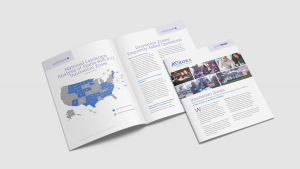Innovation Zones Offer Schools and Districts Flexibility to Reimagine and Modernize K-12 Education Post-COVID-19 – Aurora Institute

New Aurora Institute Issue Brief Examines Policies in 10 States
Innovation zones offer flexibility from regulations that are barriers for K-12 schools and districts modernizing teaching and learning. As districts consider their post-COVID futures, innovation zones present an important policy option for states to offer increased flexibility.
Innovation Zones: Policy Flexibility to Reimagine and Modernize K-12 Education Post-COVID-19, a new brief published today by the Aurora Institute, examines how 10 states established innovation zones for schools and districts. The brief is accompanied by a national landscape map illustrating where state law currently authorizes innovation zones. A set of frequently asked questions completes the offering, which is designed to support school and district leaders in understanding what innovation zones are, how they support student success, and how to go about developing them.
“It would be unjust for the American education system to simply return to its pre-COVID form,” write brief authors Fred Jones, Policy Director, and Alexis Chambers, Policy Associate at Aurora Institute. “The entire ecosystem of learning needs transformative change. Merely tweaking or tinkering with the current system will not generate the necessary change to ensure the success of all students.”
More than 25 states with existing innovation zones are using them to better meet the unique needs of their learners through new instructional models, professional development practices, mastery-based learning, providing flexibility in the use of time and talent, and other strategies.
Innovation zones can also support districts’ educational equity agendas, rising to the demands of our heightened national focus on racial equity and the exacerbated gaps in learning opportunities that Black, Brown, and low-income learners are facing in the wake of COVID-19.
“Despite dramatic improvements in the delivery of education over the last century, the one-size-fits-all, time-based system does not work as well as necessary to ensure that all student subgroups succeed,” said Susan Patrick, President and CEO of Aurora Institute. “Innovation zones provide an opportunity to pilot and target innovative new practices and supports that serve the unique needs of student subgroups who have been disproportionately affected by an education system that was not explicitly designed for their academic and emotional health in the first place.”
The brief is available for download at https://aurora-institute.org/resource/innovation-zones-policy-flexibility-to-reimagine-and-modernize-k-12-education-post-covid-19/. Find the National Landscape Analysis of States with K-12 Innovation Zones map and FAQs here: https://aurora-institute.org/our-work/center-for-policy/innovation-zones/.
About Aurora Institute
 Aurora’s mission is to drive the transformation of education systems and accelerate the advancement of breakthrough policies and practices to ensure high-quality learning for all. Aurora is shaping the future of teaching and learning for more than 14 million students through its work in policy advocacy, research, and field-building/convening. We work on systems change in K-12 education, identify root causes in structures, promote best practices, examine policy barriers, and make recommendations for change. Aurora has a national and global view of education innovation and lifts up promising policies and practices that yield improved outcomes for students. Aurora envisions a world where all people are empowered to attain the knowledge, skills, and dispositions necessary to achieve success, contribute to their communities, and advance society.
Aurora’s mission is to drive the transformation of education systems and accelerate the advancement of breakthrough policies and practices to ensure high-quality learning for all. Aurora is shaping the future of teaching and learning for more than 14 million students through its work in policy advocacy, research, and field-building/convening. We work on systems change in K-12 education, identify root causes in structures, promote best practices, examine policy barriers, and make recommendations for change. Aurora has a national and global view of education innovation and lifts up promising policies and practices that yield improved outcomes for students. Aurora envisions a world where all people are empowered to attain the knowledge, skills, and dispositions necessary to achieve success, contribute to their communities, and advance society.
